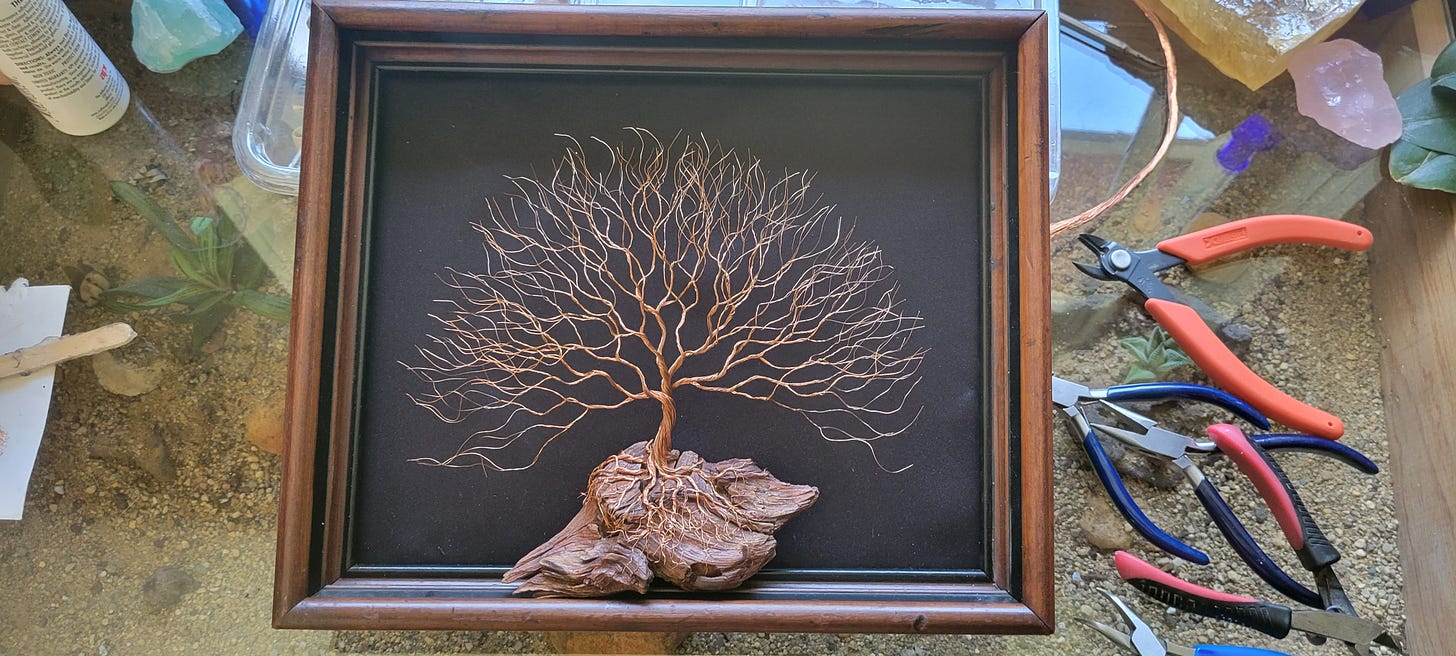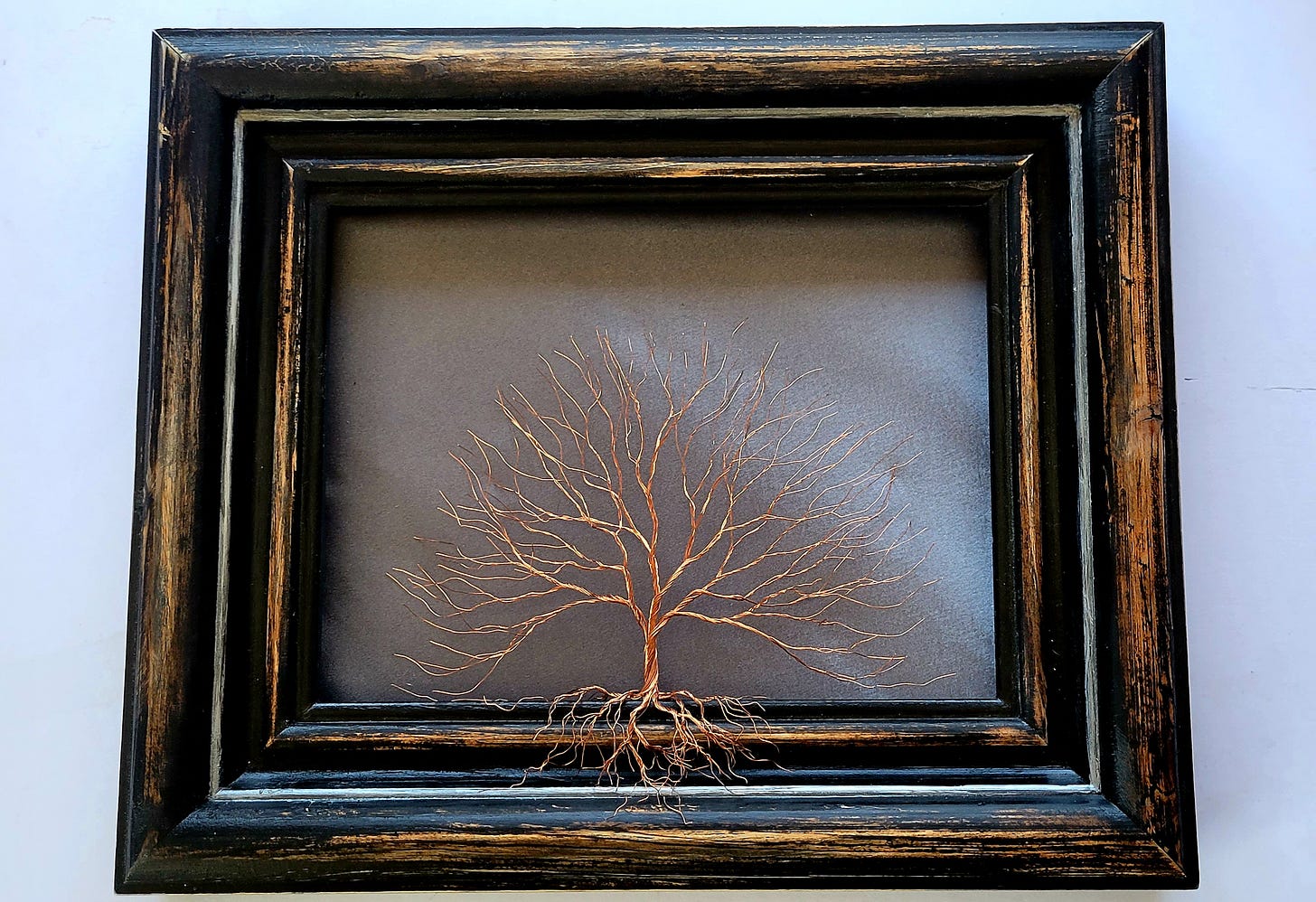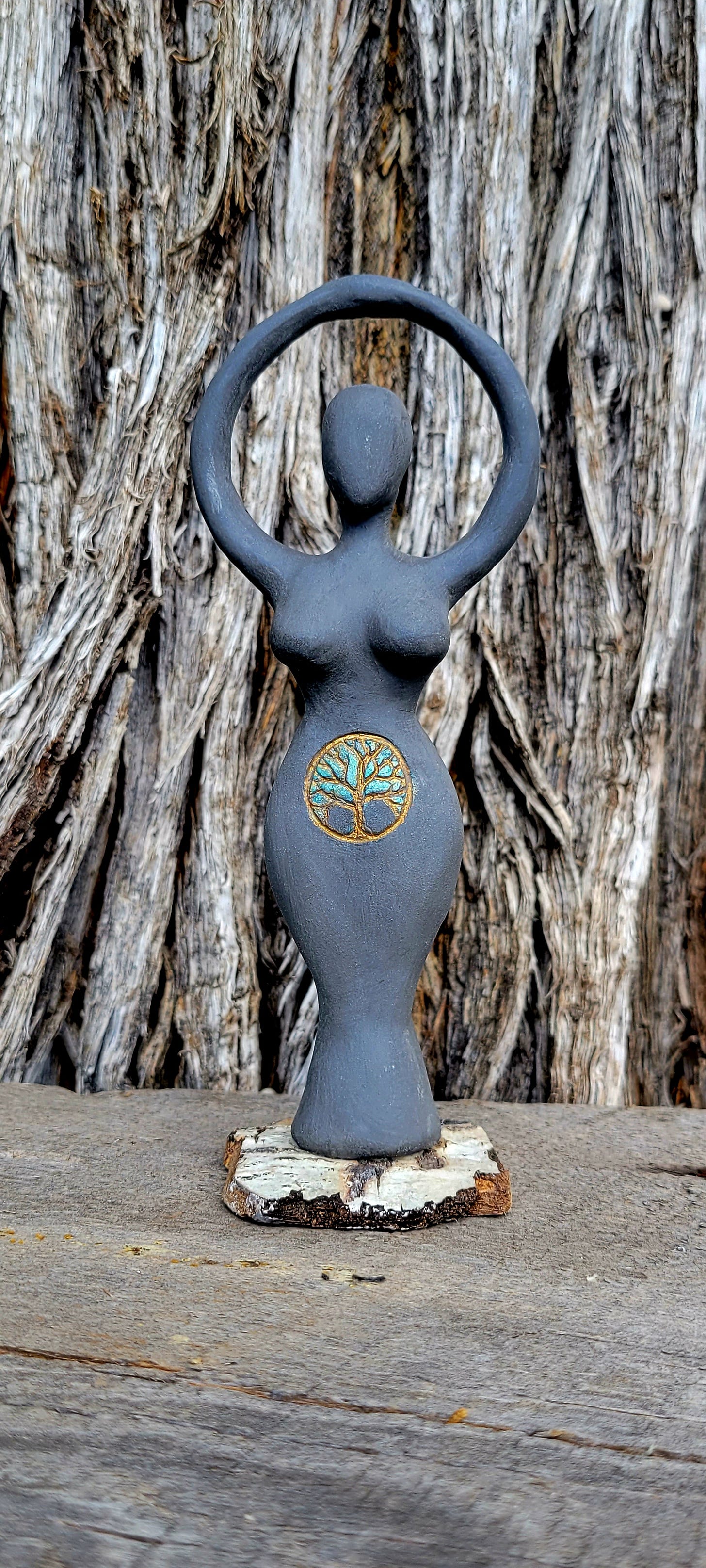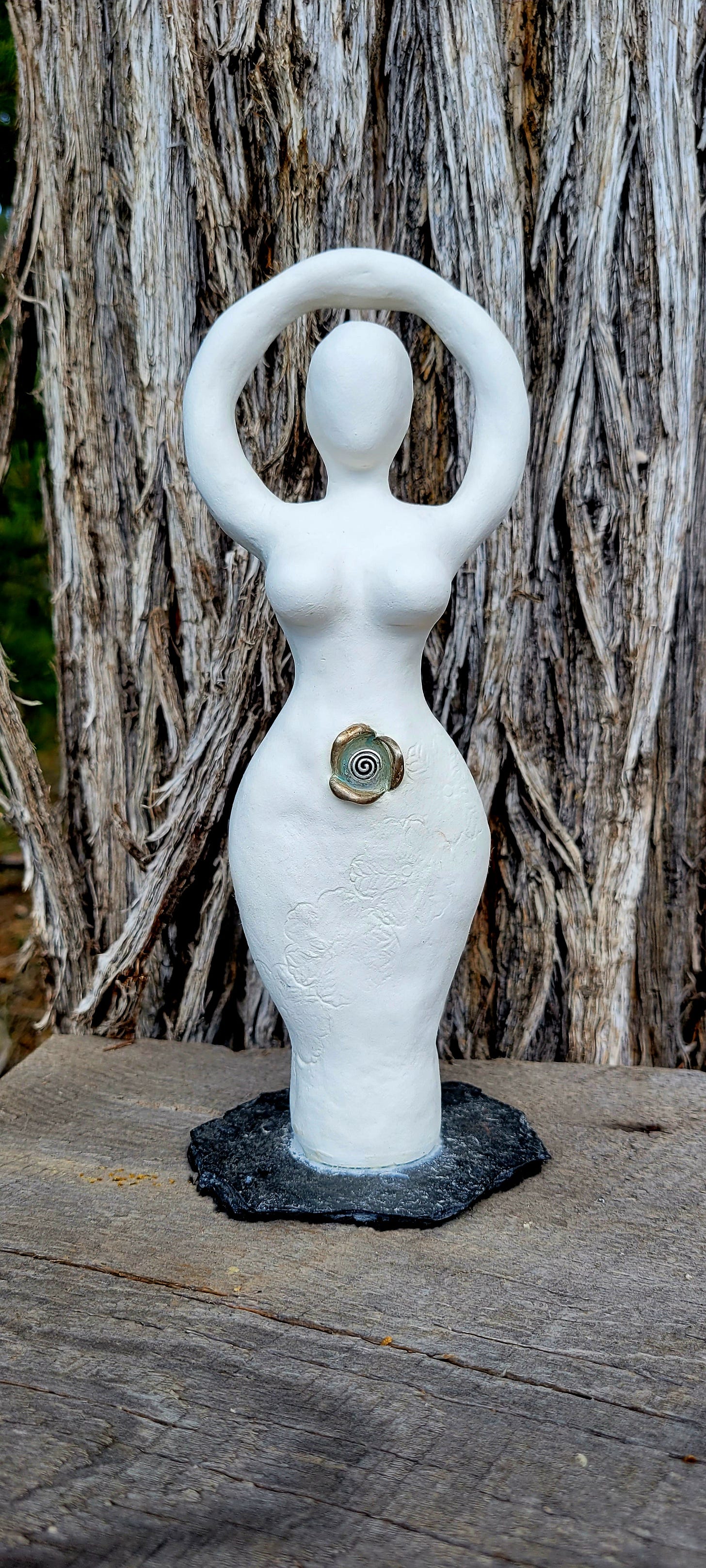Using Ritual to Connect to Our Ancestors
"It has opened up a door in my life that I wasn't aware existed."
When
and I started chatting about what a good day looks like for her, her morning routine blew me away. It sounded magical. She lives in a remote area, so she can hear bird song from her bed. When she gets out of bed, she starts her day with some yoga. Then she heads out for a hike and visits a pine tree friend, where she stays for a while, enjoying grounding and connection to earth. Each week, she does a tarot reading. For the rest of the week, she reflects upon whether she is still traveling in the direction she intended based on that reading. She also records her dreams and the symbols in them. When asked how she came to this morning routine, she said, “I do the yoga because It's good for my Body and helps my hips and it's good to stretch before I hike. And I hike because nature is the great love of my life. I love to be out there, especially in that magic hour of the morning when the air is cool and fresh and the birds are singing. And I do the meditation cuz I have trouble sometimes knowing how I'm feeling and I'm trying to learn to stay grounded in my body and feel my emotions as they arise so that I can enjoy my life more and so they don't get in the way of my creativity.”On her best days, she then gets into her writing work for the day, working on her novel or her Substack, Nomadica. However, she recently bought a trailer and started a nomadic lifestyle, so there are a lot of logistics like researching solar power, repairing her trailer, or working on her website that must happen.
For Dana, Writing+Nature=Joy
In addition to her writing, art is a part of a great day. She uses clay to make divine feminine figures and wire to make tree sculptures.
However, she’s been grappling with some major losses in her life in recent years. Several years ago, her mom died, a friend died by suicide, and her dog died. In addition, a close friendship ended and she became estranged from her sister. While this was happening, there was a wide range of emotions because she also achieved a lifelong goal of writing a novel.
She described the emotions of that time like this, “It was a weird juxtaposition of fear and sorrow and grief, and this wild joy that I was finally writing, had found my vocation, discovering I had this entire world inside me that I could escape into. The novel was very much a refuge, but I think that I had to fight so hard to get time to write in the beginning that when I was finally free, I did some spiritual bypassing because I just wanted to get back to it. I think that's why a lot of grief is coming back up now, because I'm finally at a place where I can rest and heal.”
While writing her novel, she sat for hours at a time to write. This aggravated pain in her back and the outside of her hip. She now knows exercises and stretches to keep her back feeling well, but still grapples with pain in her hips.
Her diet is normally vegetable based, with steamed veggies and salad as main foods, and some chicken and fish as well. Chocolate, coffee, and fresh-made bread bring a great deal of pleasure.
She hikes in the woods often and loves Qi Gong, but one activity that she has loved, but felt disconnected from while grieving is dance.
As we talked, three things bubbled up as my “prescriptions” to help Dana thrive.
Ritual
I am initiated in the Dagara tradition of divination. I used divination to create Dana’s ritual. During divination, we are listening to the wild spirits and the ancestors to find what we need to know and guide what needs to be done. One image that came forward was Dana walking through an underwater maze. The ritual was designed, in part, to help her bring her head back above water.
Parts of her ritual involved swimming in wild water, asking her father to help mend the wound between her and her sister. Her father is deceased, so he is wanting to help from the ancestral realm. We created a ritual to create a path for him to do that. The last part was to help her grieve the deaths and relationship losses that still weigh on her.
Take a beautiful cloth, set it on the ground.
Place small bundles of dried herbs or flowers on it (a single type of herb per bundle) like rosemary, sage, cedar, or rose petals.
Each bundle represents an important person or animal whose death you are grieving
Tell them what you love about them, anything left unsaid, what you would want to say to them if they were here now.
Each bundle represents one person, say all of the things listed above for one person, then burn the bundle before going on to the next person.
This ritual is specific to Dana, but I hope you notice the fire, water, and intention involved.
Here are a few tools for your tool box to create intentional experiences for yourself. Creating ritual or ceremony is a wonderful way to do that, so we wanted to give you a primer to get your started on creating your own rituals.
What do you need to create a ritual? Author Leo Babauta, sums it up nicely:
Environment: Create a special ambience for the ritual. That can be as simple as lighting a candle or incense, or as involved as placing stones in a circle around a bonfire. It is also important to create an environment that facilitates presence, so intentionally try to remove distractions like phones from the space.
Intention: What are you trying to cultivate, honor, or commemorate with this ritual? Is there a word that represents how you would like to feel? A transition you are marking? A loved one you are grieving or celebrating?
Presence: What makes ritual so special is how it brings us fully into the here and now.
Appreciation, Contemplation, and/or Aspiration: Use this sacred space you’ve created to focus on bringing full appreciation to what you are doing (appreciation for your body in a bathing ritual, savoring your food in an eating ritual). Or reflect on what is important to you, your fears, your aspirations. Or focus only on aspiration–what you want to create, who you want to be in the world. Ritual can give us time and space to connect to these important questions. This is the part of the ritual that is customized to your reason for engaging in the ritual.
Connect to the Sacred: So many “ordinary” things in our lives are both sacred and essential to our lives like soil, water, fire, and air (just to name a few). Attune to the elements of your ritual and how they connect you to something bigger (like the Earth or God, for example)
Express Gratitude: Close the ritual by expressing gratitude to the earth, for the time to engage in ritual, to yourself.
Here are some common components of ritual and what they represent:
Fire represents:
Transformation
Purification
Connecting to a higher power
Illumination
Fire is also used to cleanse old energies, bring new beginnings, or carry messages between the physical and spiritual realm.
Water represents:
Purification
Life
Cleansing
Renewal
Water is also used to wash away negativity, prepare for a spiritual journey, or to mark a birth or rebirth.
Stones represent:
Connection to the earth
Grounding
Stability
Stones are also used to focus intentions, mark milestones, represent the earth in the ritual, or to mark our body’s return to the earth in death.
Feathers represent:
Freedom
Spiritual connection
Honor
A link between the physical and spiritual worlds
Incense represents:
Purification
Prayer
Offering
Reverence
Impermanence
Atmosphere
Milk represents:
Purity
Nurturing
Healing
Fertility
Abundance
Mother
Wine represents:
Unity
Fertility
Connection to the Divine or Divine Blessing
Bread represents:
Fertility and creation
Metamorphosis
Remembrance
Cooperation
Seasonal cycles
Connection to community, ancestors, and a higher power
Ash represents:
Cycle of death and rebirth
Mourning
Repentance
Ash or salt can also provide protection in rituals.
You can combine these components to mark beginnings and endings in your own life to to make an offering to ask for help in an area of struggle in your life. Here are a few examples of rituals I have created in my own life:
I gathered a small group of healthcare workers. We each brought a small container with rocks (to represent difficult situations or people we still carry with us) and water to represent the grief. Each person shared as much or as little of those stories as they wished as we sat by the fire. We then poured them into a shared container, showing us all holding them together, then offered it all to the earth.
To help me let go of my own grief related to COVID, I scattered ash in a small square around myself to the north, south, east, and west. I then washed my hands in milk to represent healing and nurturing.
To mark a transition in my career, I buried my feet in the earth and read a “graduation speech” I wrote for myself aloud.
To build connection to the spirits of my local watershed, I brought an offering down to the river. I offered ash and milk to the river, followed by a small bundle of flowers and fruit, with a song.
There’s no wrong way to do this. Think about the occasion you are marking and what you are hoping to cultivate in yourself or your life. It can be as simple as lighting a candle and drinking a cup of tea each morning in silence (or as quiet as it is when your kids go off to play).
Movement to Support Hips/Core/Pelvic Floor
Many times when people are struggling with back, hip, or pelvic pain, people recommend a set series of stretches (hamstring stretches, hip flexor stretch, figure 4/pigeon pose). However, particularly for figure 4 stretches, two issues can arise.
If you stretch in a range of motion beyond which your muscles can provide stability, your pelvis can be destabilized by the stretch and increase the likelihood of pain at the front of your pelvis or near your tailbone.
If you have to tuck your pelvis to get into the figure 4 position, it will be very difficult to grab onto your thigh without bulging your abs and pelvic floor, putting more strain on both.
This video below shows some alternatives to figure 4 stretch for stretching the hips/pelvis/pelvic floor and some progressions you can do toward the figure 4 stretch. Many of these moves are inspired by Lauren Ohayon’s Restore Your Core program, so if you like them, you may want to check out her program.
In her program, she emphasizes activating the reflexive core, the transversus abdominus muscle. You can do this by blowing like you are blowing out candles. When you do this, you’ll feel your abs cinch in, rather than bulge out like they do when you flex your rectus abdominus muscles (the muscles that make a six-pack) like you might do when you brace for being punched. She also emphasizes three dimensional movement of the spine and internal and external rotation of the hips. There are a few spots in the video where it is difficult to hear because my head is turned. The only place it was hard to hear something important is at the part where your feet are moving back and forth, once you have done that a couple times, turn your head to peek back at your feet, that way you have internal and external rotation of the hips as well as bending of the spine.
Sad Dance Playlist
Dana loves to dance, but usually dances when she is feeling happy. Fortunately, dance is a great tool for expressing all of our emotions, we just move our bodies in a different way to express them. I created this sad dance playlist for Dana, in the hopes that it will help her express herself and do more of something she loves. Maybe it will get you dancing too.
Final Thoughts
Thanks again to Dana for being our intrepid first participant in these interviews. You can find her Substack here. She also sells her art, so send her a message on Substack if you’re interested. I hope if you see some of her experience in your experience that you give these activities a try! Also, if you’re interested in being one of my interviewees, please respond to this email or message me. Dana felt comfortable sharing her name and her art, but I can definitely share your experience anonymously as well!






That art is gorgeous!!
Thanks again Amy, for sharing your knowledge, wisdom and insights. This has been such a positive experience. I feel very fortunate to have taken part in it. I love the combination of western medicine, yoga, and emotional and energetic healing thru ritual and connection with our ancestors. I think a holistic approach to our health and the health of the planet is desperately needed in this culture and finding a medical doctor who is bringing all of this together is deeply inspiring. Thank you for all that you do!